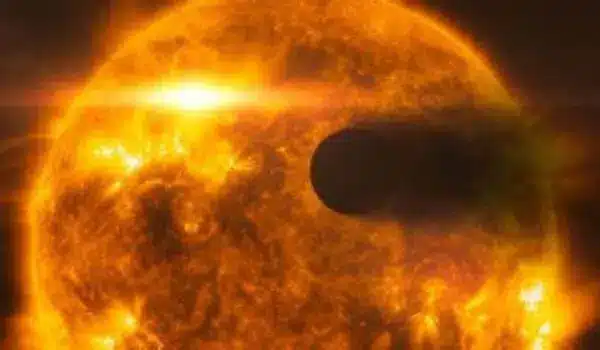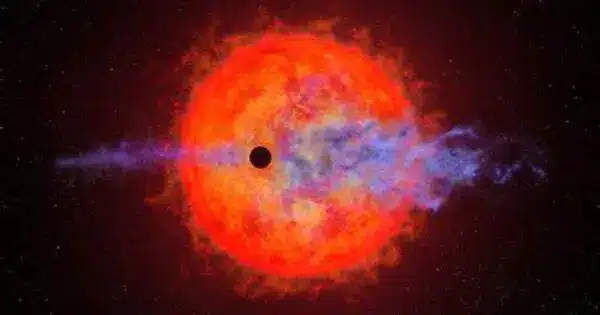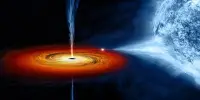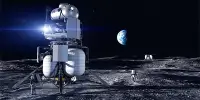The Hubble Space Telescope has made countless amazing discoveries and observations of exoplanets, distant galaxies, and the universe in general. A young planet swirling around a grumpy red dwarf star is changing in unanticipated ways. It is so close to its parent star that it is subjected to a constant stream of energy, which evaporates its hydrogen atmosphere, causing it to puff off the planet.
However, during one orbit spotted by NASA’s Hubble Space Telescope, the planet appeared to be losing no material at all, whereas another orbit recorded by Hubble a year and a half later revealed significant indicators of atmosphere loss.
Astronomers were taken aback by the remarkable diversity between orbits. “We’ve never seen atmospheric escape go from completely undetectable to very detectable in such a short period when a planet passes in front of its star,” Dartmouth College’s Keighley Rockcliffe in Hanover, New Hampshire, said. “We were hoping for something very predictable and repeatable.” But it turned out to be strange. When I initially saw it, I thought to myself, ‘That can’t be right.'”
We’ve never seen atmospheric escape go from completely undetectable to very detectable in such a short period when a planet passes in front of its star. We were hoping for something very predictable and repeatable.
Keighley Rockcliffe
Rockcliffe was equally puzzled to see, when it was detectable, the planet’s atmosphere puffing out in front of the planet, like a headlight on a fast-bound train. “This frankly strange observation is kind of a stress-test case for the modeling and the physics about planetary evolution. This observation is so cool because we’re getting to probe this interplay between the star and the planet that is really at the most extreme,” she said.
The parent star AU Microscopii (AU Mic), 32 light-years from Earth, is home to one of the youngest planetary systems yet discovered. The star is less than 100 million years old (a minuscule fraction of our Sun’s lifetime of 4.6 billion years). The innermost planet, AU Mic b, orbits the star every 8.46 days and is only 6 million miles away. The bloated, gaseous world is roughly four times the size of Earth.
In 2020, NASA’s Spitzer and TESS (Transiting Exoplanet Survey Satellite) satellite telescopes identified AU Mic b. It was discovered using the transit method, which means that telescopes may see a minor decrease in the brightness of the star when the planet passes in front of it.

Red dwarfs like AU Microscopii are the most abundant stars in our Milky Way galaxy. They therefore should host the majority of planets in our galaxy. But can planets orbiting red dwarf stars like AU Mic b be hospitable to life? A key challenge is that young red dwarfs have ferocious stellar flares blasting out withering radiation. This period of high activity lasts a lot longer than that of stars like our Sun.
The flares are powered by intense magnetic fields that get tangled by the roiling motions of the stellar atmosphere. When the tangling gets too intense, the fields break and reconnect, unleashing tremendous amounts of energy that are 100 to 1,000 times more energetic than our Sun unleashes in its outbursts. It’s a blistering fireworks show of torrential winds, flares, and X-rays blasting any planets orbiting close to the star. “This creates a really unconstrained and frankly, scary, stellar wind environment that’s impacting the planet’s atmosphere,” said Rockcliffe.
Under these torrid conditions, planets forming within the first 100 million years of the star’s birth should experience the most amount of atmospheric escape. This might end up completely stripping a planet of its atmosphere.
“We want to find out what kinds of planets can survive these environments. What will they finally look like when the star settles down? And would there be any chance of habitability eventually, or will they wind up just being scorched planets?” said Rockcliffe. “Do they eventually lose most of their atmospheres and their surviving cores become super-Earths? We don’t really know what those final compositions look like because we don’t have anything like that in our solar system.”
While the star’s glare prevents Hubble from directly seeing the planet, the telescope can measure changes in the star’s apparent brightness caused by hydrogen bleeding off the planet and dimming the starlight when the planet transits the star. That atmospheric hydrogen has been heated to the point where it escapes the planet’s gravity.
The hitherto unseen fluctuations in AU Mic b’s atmospheric outflow may indicate rapid and dramatic variability in the host red dwarf’s outbursts. Because the star has many churning magnetic field lines, there is a lot of unpredictability. One possible explanation for the missing hydrogen during one of the planet’s transits is that a powerful stellar flare seen seven hours earlier photoionized the escaping hydrogen to the point where it became transparent to light and thus unobservable.
Another possibility is that the stellar wind itself shapes the planetary outflow, making it visible at times and not visible at others, and perhaps causing some of the outflow to “hiccup” ahead of the planet. Some models, such as those of John McCann and Ruth Murray-Clay of the University of California, Santa Cruz, predict this, but this is the first type of observational proof of it happening and to such an extreme degree, according to academics.
Hubble follow-up studies of more AU Mic b transits should provide more information on the star and planet’s unusual variability, putting scientific models of exoplanetary atmosphere escape and evolution to the test.
















